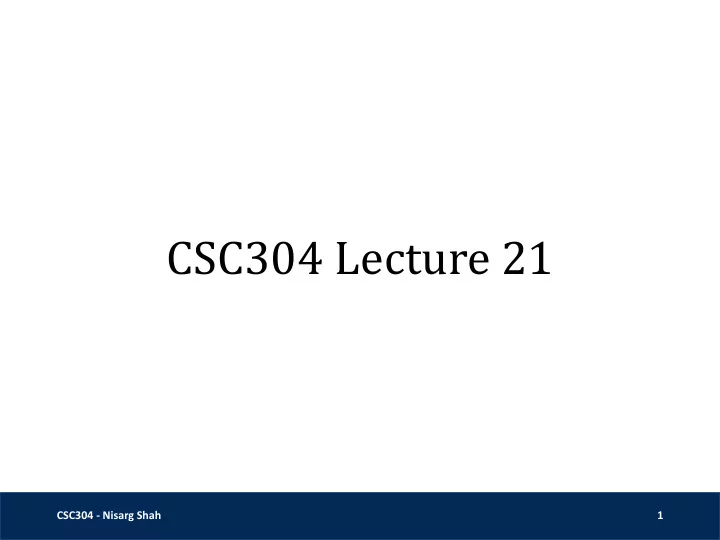

CSC304 Lecture 21 CSC304 - Nisarg Shah 1
Complete your course evaluations… Check your e-mail for a link to your evaluations, or log-in to www.portal.utoronto.ca and click the Course Evals tab!
REVIEW (Of most concepts) CSC304 - Nisarg Shah 3
Part I: Game Theory • Normal (matrix) form games • Strategies: pure & mixed • Weak/strict dominance ➢ Strategy A dominates strategy B ➢ Iterated elimination of dominated strategy ➢ Strategy A is dominant • Nash equilibrium: pure and mixed ➢ Nash’s theorem CSC304 - Nisarg Shah 4
Part I: Game Theory • Price of anarchy and stability ➢ Anarchy: Worst NE vs social optimum ➢ Stability: Best NE vs social optimum ➢ PoA ≥ PoS ≥ 1 • Potential functions ➢ Cost-sharing games ➢ Braess ’ paradox • Zero-sum games ➢ The minimax theorem • Stackelberg games, Stackelberg equilibrium CSC304 - Nisarg Shah 5
Part II: Mech Design w/ Money • Goals: social welfare or revenue • Incentive guarantees: ➢ Dominant strategy incentive compatibility (DSIC) ➢ Bayes-Nash incentive compatibility (BNIC) • VCG mechanism ➢ DSIC + maximizes social welfare on every instance ➢ Sponsored search, comparison to GSP • Myerson’s auction ➢ BNIC + maximizes expected revenue among all BNIC mechanisms CSC304 - Nisarg Shah 6
Part II: Mech Design w/ Money • Revelation principle • Revenue equivalence principle • 1 st price auction and its equilibrium • Ascending auction CSC304 - Nisarg Shah 7
Part III: Mech Design w/o Money • Facility location • Social cost ➢ The median mechanism • Maximum cost ➢ The left-right-middle mechanism • Stable matching ➢ Gale-Shapley deferred acceptance algorithm CSC304 - Nisarg Shah 8
Part IV: Voting • Ranked voting • Voting rules • Gibbard-Satterthwaite theorem • Axiomatic approach to voting ➢ Strategyproofness ➢ Strong / weak monotonicity ➢ Consistency ➢ Condorcet consistency • Impartial selection CSC304 - Nisarg Shah 9
Part V: Fair Division • Cake-cutting ➢ Proportionality and envy-freeness ➢ Robertson-Webb model • 2-players ➢ Cut-and-choose • 3+ players proportional ➢ Dubins-Spanier protocol ➢ Even-Paz protocol • Pareto optimality • Strategyproofness via perfect partition CSC304 - Nisarg Shah 10
Part V: Fair Division • Indivisible goods ➢ Envy-freeness up to one good ➢ Maximum Nash Welfare allocation • Computational resource allocation ➢ Dominant Resource Fairness (DRF) • Classroom allocation ➢ The leximin mechanism • Rent division ➢ Utilitarian allocation CSC304 - Nisarg Shah 11
Recommend
More recommend